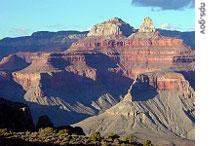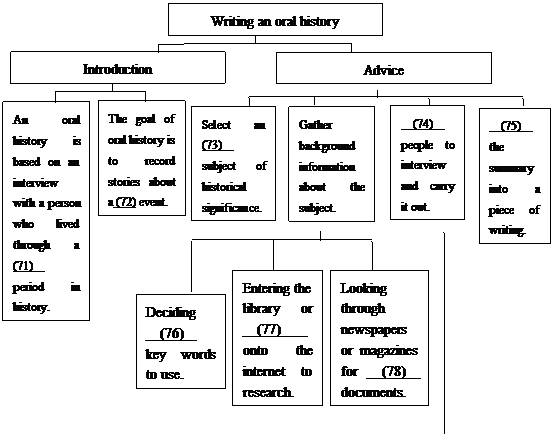
科目: 来源: 题型:阅读理解
The Grand Canyon (峡谷) in Arizona extends four hundred fifty kilometers. The canyons look as if they formed as the earth split apart. They were actually cut by rivers.
Looking at the Grand Canyon is like looking back in time. Forty million years ago, the Colorado River began cutting through the area. At the same time, the surrounding land was pushed up by forces deep within the Earth. Rain, snow, ice, wind, and plant roots rubbed away at the top of the new canyon. Below, the flowing river continued to uncover more and more levels of ancient rock. Their appearance changes endlessly -- with the light, the time of year, and the weather.
 The Grand Canyon has several weather environments. The top is often much different from the bottom. On some winter days, for example, you may find cold winds and snow at the top. But at the bottom, you may find warm winds and flowers.
The Grand Canyon has several weather environments. The top is often much different from the bottom. On some winter days, for example, you may find cold winds and snow at the top. But at the bottom, you may find warm winds and flowers.
The Grand Canyon is known as one of the seven wonders of the natural world. About five million people visit the canyon each year. Most visitors walk along paths part way down into the canyon. Some visitors ride mules to the bottom and back.
There are several other ways to visit the Grand Canyon. Hundreds of thousands of people see the canyon by air each year. They pay a helicopter or airplane pilot to fly them above and around the canyon.
About twenty thousand people a year see the Grand Canyon from the Colorado River itself. They ride boats over the rapid, rocky water. These trips last from one week to three weeks.
Visitors can see the Grand Canyon in still another way. A huge glass walkway, called the Skywalk, extends from the edge and is hanging above the bottom of the canyon.
Some people say the Skywalk is an engineering wonder. However, other people have criticized the Skywalk and future development. They say it harms a national treasure and reduces the enjoyment of nature in the Grand Canyon.
1. We can learn from the first paragraph ____________.
A. the Grand Canyon is the most beautiful place in America
B. the Grand Canyon is four hundred fifty kilometers long
C. the Grand Canyon used to be a dried river
D. the Grand Canyon used to be a deep opening in the earth
2. According to the passage, people can visit the Grand Canyon in ______ ways.
A. 3 B. 4 C. 5 D. 6
3. We can learn that the author of the passage hold a(n) ______ attitude towards the Skywalk.
A. positive B. negative C. objective D. critical
4. All the following are true about the Grand Canyon EXCEPT ____________.
A. The top of the Grand Canyon is always cold.
B. The Grand Canyon displays different colors in different times.
C. The Grand Canyon is as old as forty million years old.
D. Every year more people see the Grand Canyon by air than by boat.
查看答案和解析>>
科目: 来源: 题型:阅读理解
第四部分:任务型阅读(每小题1分,满分10分)
请认真阅读下列短文,并根据短文的内容要点完成文章后的表格。注意:补全填空应符合语法和搭配要求,每空只填一个单词。请将答案写在答题纸上的相应位置。
An oral history is a piece of writing based on an interview with a person who has lived through a significant period in history or experienced a historical event. His or her memories provide a personal view of the past.
The first goal of all oral histories is to record stories about a specific subject. That subject may be a historical event like the D-Day invasion. It may be a period of history like the Depression, or a social or cultural trend, such as child labor. The first step in an oral history project, therefore, is to select a subject that interests you and is of historical significance.
Before attempting to identify people to interview for your project, you must first gather background information about the subject. The Library of Congress, which houses thousands of oral histories, provides these tips for researching your subject.
Before entering the library or logging onto the internet, decide on key words to use in your search. Use detailed search words. For example, search for rock and roll of the ’60s instead of the more general term music.
Look through newspaper and magazine articles and Internet Web sites to identify documents that are related to your subject. Make copies of those that will help you plan your interview questions and discard all others.
Discuss what you’ve read about your subject surprised you? What aspect of your subject would you like to know more about? Asking questions like these will help you to focus your subject and to identify the voice or voices you need to interview.
Oral histories are as much about self as they are about subject. One goal of an oral history interview is to find out what happened. A second and equally important goal is to discover how people reacted to or were affected by what happened. The person you select to interview, therefore, should have had some experience with the subject – either as a participant or a witness.
Once you have identified one or more people to interview, begin preparing your questions. The best questions are open-ended, encouraging the speaker to respond with more than a mere “Yes” or “No.” For example, an interviewer might have asked Clarence Hughart this question about his D-Day experience: Were you scared? That question, however, would probably not have elicited the sort of dramatic storytelling that Hughart provided.
Make a list of ten possible interview questions. The first two or three should be fairly general, asking the interviewee to talk about his or her childhood, perhaps. These kinds of questions put people at ease. Save more sensitive questions until the interview has been underway for five, 10, or 15 minutes or more.
After the interview come the final steps: writing a summary of the interview and then shaping it into a finished piece of writing.
 | |||
 | |||
查看答案和解析>>
科目: 来源: 题型:
Some parents are just too protective. They want to_________their kids from every kind of danger, real or imagined.
A. spot B. dismiss C. shelter D. distinguish
查看答案和解析>>
科目: 来源: 题型:
What do customers demand __________to make up for their loss?
A.be done B.to be done C.is doing D.is to do
查看答案和解析>>
科目: 来源: 题型:
On weekends when Jane comes back home from school, she eats everything in _____.
A. scene B. sight C. view D. range
查看答案和解析>>
科目: 来源: 题型:
The general joy of driving cars in video games is the careless feeling; you can bravely overtake other cars without ________.
A. fining B. fine C. fined D. being fined
查看答案和解析>>
科目: 来源: 题型:
The teachers in Senior High Three would like to answer ______ worry the students, especially when the College Entrance Examination is coming.
A. all the questions they think B. whatever questions they think
C. any questions they think D. whatever questions they think that
查看答案和解析>>
科目: 来源: 题型:阅读理解
In 1961, scientist set up gigantic, sensitive instruments to collect radio waves from the far reaches of space, hoping to discover in them some mathematical pattern indicating that the waves were sent out by other intelligent beings. The first attempt failed, but someday the experiment may succeed.
What reason is there to think that we may actually detect intelligent life in outer space?To begin with, modern theories of the development of stars suggest that almost every star has some sort of family of planets. So any star like our own sun (and there are billions of such stars in the universe) is likely to have a planet situated at such a distance that it would receive about the same amount of radiation as the earth.
Furthermore, such a planet would probably have the same general composition as our planet; so, allowing a billion years or two or three, there would be a very good chance for life to develop, if current theories of the origin of life are correct.
But intelligent life?Life that has reached the stage of being able to send radio waves out into space in a deliberate pattern?Our own planet may have been in existence for five billion years and may have had life on it for two billion, but it is only in the last fifty years that intelligent life capable of sending radio waves into space has lived on earth. From this it might seem that even if there were no technical problems involved, the chance of receiving signals from any particular earth-type planet would be extremely small.
This does not mean that intelligent life at our level does not exist somewhere. There are such an unimaginable number of stars that, even at such miserable possibility, it seems certain that there are millions of intelligent life forms scattered through space. The only trouble is, none may be within easy distance of us. Perhaps none ever will be; perhaps the distances that separate us from our fellow “creatures” of this universe will forever remain too great to be conquered. And yet it is conceivable that someday we may come across one of them or, frighteningly, one of them may come across us. What would they be like, these outside-the-earth creatures?
1.What point is the author making by stating that almost every star has some sort of family of planets?
A. Sooner or later intelligent beings will be found on one of the stars.
B. There must be one or two of the planets on which there are no intelligent beings.
C. There are sufficient planets for there to be one that enjoys the same conditions as the earth does.
D. One or two billion years later intelligent beings will generate on those planets.
2.What is the main topic of the passage?
A. Some probable intelligent life forms on other planets.
B. Various stages undergone by the intelligent life on other planets.
C. Grounds for probable existence of intelligent life on other planets.
D. The possibility of intelligent life existing on our planet.
3.Which of the following can be inferred from the passage?
A. An encounter is probable between people from the earth and intelligent beings from another planet.
B. Though the first attempt failed, scientists did discover the radio waves sent out by other intelligent beings.
C. Other intelligent beings were able to send our radio waves into space well before the last fifty years.
D. It is certain that there are millions of intelligent beings scattered in space but only too far away.
4.According to the author, what is the difference between “we may come across one of them” and “one of them may come across us”?
A. The earth would be dangerously disadvantaged if it is sought after by possibly much more developed creatures.
B. It would prove that there are too many outside-the-earth creatures if “one of them comes across us”.
C. The history of the development of the earth would be proved to be shorter than that of “them” if “they” come across us.
D. it would prove that the distance in between is not so great as we think if “we come across one of them” someday.
查看答案和解析>>
科目: 来源: 题型:
书面表达(满分35分)
假如你是李华,你的好友Tom不善于交际,来信总是向你诉说他在交往方面的烦恼,请你就此向你的朋友提出一些建议。建议内容包括以下几点:
1. 宽容 2. 多微笑 3. 和别人在一起时,不要保持沉默
注意:1. 词数120字左右
2. 可适当增添细节,以使行文连贯。
Dear Tom, _____________________________________________________________________________________________________________________________________________________________________________________________________________________________________________
Best wishes,
Yours,
Li Hua
查看答案和解析>>
科目: 来源: 题型:
It is ____ you deal with difficulties that shows ____ you are really like.
A. what; what B. how; what C. how; that D. which; how
查看答案和解析>>
湖北省互联网违法和不良信息举报平台 | 网上有害信息举报专区 | 电信诈骗举报专区 | 涉历史虚无主义有害信息举报专区 | 涉企侵权举报专区
违法和不良信息举报电话:027-86699610 举报邮箱:58377363@163.com